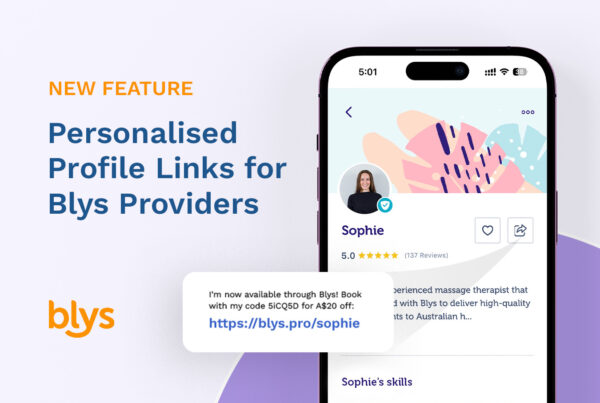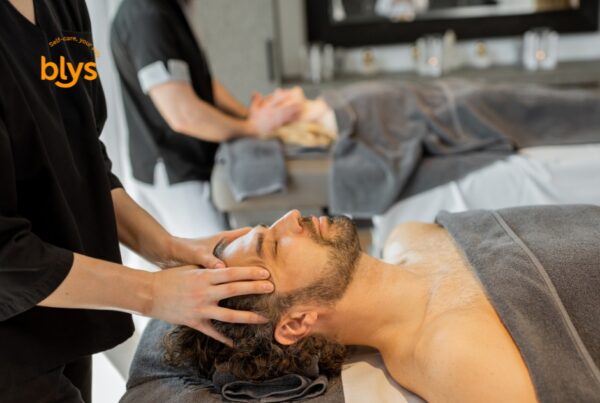
In light of this, we’ve broken down some our top tips to help you earn those valuable rebooking requests.
1. Make a Personal Connection with Your Clients
This is the most important thing to attract loyal and consistent clients. When you take the time to make a genuine connection, your client will appreciate it and is more likely to rebook with you.
- When meeting a client for the first time, try saying their name several times before, after or during the session. It is likely that they will feel more personally connected to you. People genuinely appreciate when others make the effort to remember their name and use it.
- Take notes when speaking with your client, then use the info you gathered later. If your client mentions they have had persistent chronic neck pain, ask if their neck feels any better since their last massage. Incorporating personal touches like this shows you truly care about your clients’ well-being, which encourages them to use your services again in the future.
- Go one step further and keep personal notes on your clients. Write down events or people your client mentions during their session, and ask about them next time you see them. Going above and beyond in your customer service by paying attention to important things in your clients’ lives is appreciated and will make you more memorable.
2. Focus on the Client’s Needs/Wants
Your clients want to be heard. Ask them what they want to get out of their massage from the start: are looking for relaxation, help with a problem area, or a bit of both? Clarifying this in the beginning helps you to create a plan for your massage and also makes the client believe you care about what they need.
Ask them where they feel the pain, then make sure to address that area in the treatment. Remind yourself of the results they want. Even if you know the cause of the pain is in another area, let them know that you’ll work on where they feel the pain but also on the other muscle groups involved for the best results.
Some clients just need to relax! Be mindful of that as well. If your client is telling you what they want from their massage, then there’s no confusion about what will make them leave happy and wanting to rebook.

3. Establish Yourself as an Expert
As practitioners, we have the knowledge and training, but sometimes we forget to let the clients know that. This is important to establish from the initial assessment so that the client feels comfortable.
- Tell them about what you notice, feel, or see.
- Find out where they are having pain, then explain to them the muscle groups that may be causing their problem.
The physical assessment allows you to come back at the end of the session and reassess. See where there have been gains and also discuss areas that still need improvement in further sessions if necessary. If you are treating a client, and in your professional opinion they would benefit from a weekly or monthly visit, then tell them. You’re the expert!
4. Educate Your Clients About the Benefits of Massage
Spend some extra energy with first-time clients discussing the health benefits of massage therapy and why it’s crucial to see a massage therapist more than once or twice a year.
You can use phrases like:
- “Massage can be great for a wide variety of health issues; insomnia, depression, anxiety, or even high blood pressure.”
- “Committing to regular massages is a great tool for pain management.”
- “Regular massage sessions help alleviate stress and have been proven to boost immunity naturally.”{
With understanding comes action. If your clients understand just how effective massage can be for treating many injuries, conditions, and health concerns, then they will be more likely to schedule additional massage appointments with you. Simply taking a few extra minutes to talk with your client about the benefits of massage and address any concerns can go a long way.
5. Talk About the Changes/Improvements You’ve Made in Your Session
Have your client perform range-of-motion exercises at the beginning and end of the session so they can see the improvements for themselves. Talk about what has gone well, what still needs work, and where to go from here.
You can say things like:
- “This loosened up a bit, but it still needs more work…”
- “We’ve made some progress, but there’s still more work to be done…”
- “I can see you can actually move that arm! That’s great, We really made some progress.”
- “Wow, you can lift your arm higher and higher after each massage session.”
Continue to discuss the improvements at the end of each session. If they keep hearing about how things are getting better for them, they will continue to rebook.

6. Come Up with a Treatment Plan
When the first session comes to an end, tell your client what you can provide in your next session and what they can expect to gain from the treatment. This will encourage your client to consider scheduling an additional appointment with you.
Document a treatment plan and explain why a regular visit will benefit them. Clients will respect your professionalism and will listen to your advice. They will also value a therapist who provides an appropriate massage session plan to expedite healing of their individual condition.
Here are some suggested phrases:
- “I would be happy to design a program for you that includes massage therapy treatments and some exercises you can do at home. Would you be interested in that?”
- “Your neck and shoulders were quite tight, and although we made some progress today loosening them up, I would recommend that you come back in 1 to 2 weeks for a follow-up session. We can do a targeted session on your neck and shoulders or combine that with a full body massage. Is Thursday afternoon a good time for you?”
Give your client a specific time frame to come back to see you.
You can use phrases like:
- “I’d recommend coming back within ___ weeks, so that we can build on the improvements we made today.”
- “We made good progress today but this will tighten up again. I think you should rebook again in ___ weeks.”
- “I’d like to see you again in ___ weeks to continue the great work we did today.”
Suggest a few specific dates/times you would be available to rebook:
- “I have available appointments next week on (say days you’re free)”
- “I am usually relatively busy, so I’d love to go ahead and get you booked in. My next available appointments are on (give specific dates/times)”
Providing a clear plan with a timeframe to come back can help to reassure of the next steps. Also, explain to your client how many sessions you typically recommend for their particular condition or concern. Give them valuable information and a solid reason to rebook.
7. Give Homework to get First Timers to Come Back
When the first session is over, give your client a list of recommendations to take home. Recommendations may include advising the client to complete certain stretches, use self-massage techniques, and scheduling more follow up sessions. When you actually put in writing that the client would benefit from a massage twice a month the client will be more likely to take your suggestion more seriously and schedule another appointment.
8. Give Your Clients the Opportunity to Rebook on the Spot
Nobody like a pushy professional, but asking your clients if they would like to reschedule in a nice way is crucial to generating repeat customers.
Try these phrases:
- “Would you like me to come back next week?”
- “Would you like to schedule a follow-up appointment before you leave?”
- “Each time you have a massage with me, we get closer to helping your body give you less pain and more flexibility.”
- “I can also give you some stretching exercises to maintain the relief you are feeling right now, but it does work best if you have weekly or fortnightly treatments.”
- “Would you like to keep this feeling going by rebooking/making another appointment?”
Asking the right question before a client leaves will encourage them to rebook before they forget later on.

9. Help Clients to Focus on Long Term Goals
With our established clients, conversations may also be steered towards long-term goals. Helping our regular clients view long-term goals for their life can make a huge impact in their minds and can encourage them to make healthier choices.
Whatever goals they are trying to reach, let them know how massage can help with those. Remind them of the many long-term benefits of regular massage: easing anxiety and depression, relieving joint pains and arthritis, decreasing muscle tension, uplifting their mood, eliminating headaches, more focus and clarity, improving blood circulation, and increasing the quality of sleep.
10. Give Your Clients Permission to Take Care of Themselves
If we are not rebooking our clients they will often leave it too long between treatments and go backwards in their improvements. Most people will need a massage within 4–6 weeks to loosen up, maintain range of movement and/or have someone assess their body to pick up possible areas that could become an issue in time. These are maintenance massages.
You can say:
“I know that your life is busy and that you’re under a lot of pressure, but in order to take care of others we have to take care of ourselves! I would recommend you book in every two to four weeks to experience the ongoing benefits of massage therapy.”
Sometimes people just really need someone to give them permission to take care of themselves.
Bonus Tip: Have Confidence
You know your craft, and it’s ok to sell yourself. Show your clients how they can rebook you.
Reasons to feel confident asking clients to rebook:
- You gave them a great massage.
- They are supremely happy.
- You know you can help them with their pain management, chronic condition, or athletic goals.
We all know the old adage “practice makes perfect”. So, go get in front of a mirror, and start practicing the phrases you will use to ask people if they would like to rebook. You can do this!




